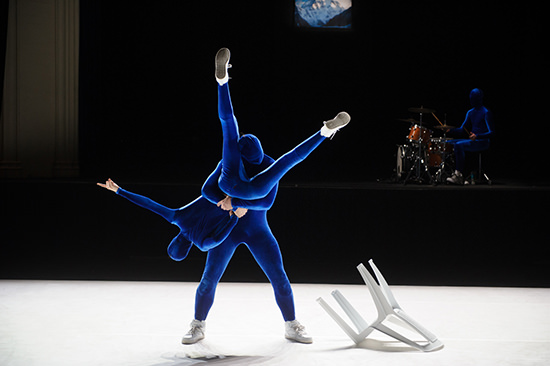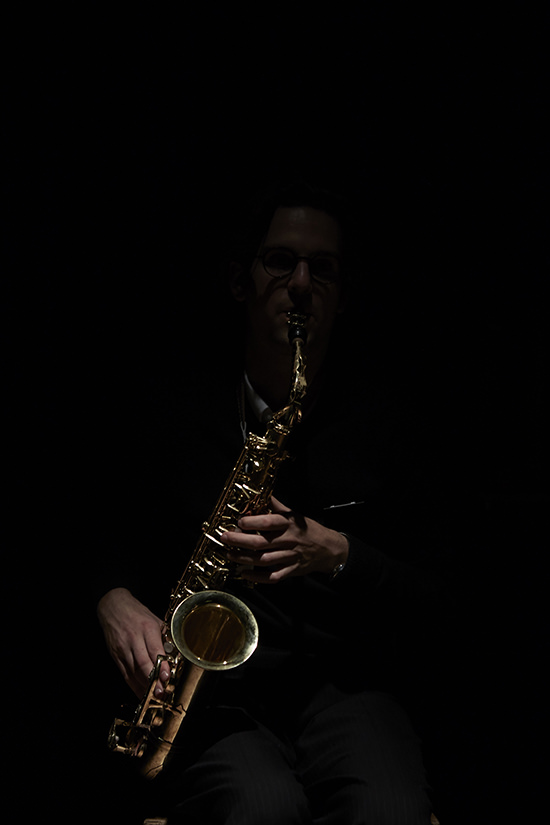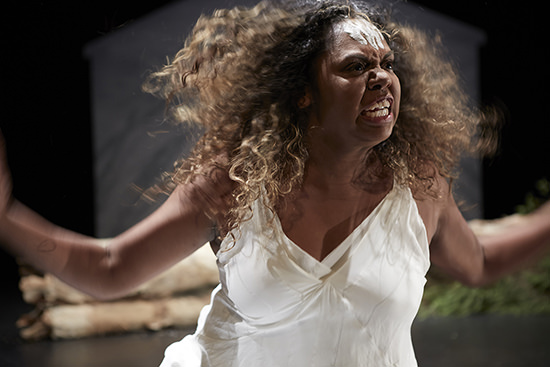Next Wave, a festival of creative attentiveness
Simon Eales: CAMEL, The Horse, [MIS]CONCEIVE, BlaaQ Catt

CAMEL, Next Wave 2016
photo Sarah Walker
CAMEL, Next Wave 2016
In her program notes, Next Wave artistic director Georgie Meagher writes that this year’s festival, unlike its predecessors, focuses on “learning” rather than “development.” For Meagher, learning can be “slow and meandering. It can be useless. Learning can make things seem more complicated and interconnected than we ever thought.” An invitation to learn is an invitation to listen more deeply, and be less intent on finding a work’s final meaning. We become creators too. This is an important framework with which to approach pieces like CAMEL and The Horse, which are, to use Meagher’s words, “stuffed with disparate things banging around against each other,” and the presence of so-called peripheral cultural voices in the festival, as in BlaaQ Catt and [MIS]CONCEIVE, produced by Indigenous artists.
CAMEL
With questions around the nature of creative intuition at its core, young Victorian choreographer, auteur and couturier Geoffrey Watson’s CAMEL produces compellingly clear motifs. Following them is not the point, but they’re glorious to revel in. The staging is simple: a white dance floor expanse before the Arts House main hall stage, on which sits a drum kit, and above which, smaller than you would imagine, hangs a backlit portrait of snowcapped peaks by local image-maker Thomas Russell. Two performers are present, sprawled over white plastic patio chairs, facing each other across the dance floor. Each is in a Blue Man Group-esque, full-body morph suit, a costume choice that hints to the work’s overriding humour. Later, for example, in a section parodying romantic love, the robotic voice-over incants, “I’ll harden to ice and wait for you in the fridge.” The same voice blurts the jussive, “fuck Debussy in the ass,” when classical ballet and its modes are being run through the ringer. It could easily be a live version of a viral video made on the website GoAnimate.

CAMEL, Next Wave 2016
photo Sarah Walker
CAMEL, Next Wave 2016
Experiencing CAMEL through knowledge of Watson’s background in classical ballet illuminates one particular strain of the work’s farraginous constitution. As suburban debris, slurpees play a big part in the second half. They’re sucked, spilled and their cups are rhythmically ground into the floor. They leave tracks, reminding me of a 7-Eleven on a 40 degree day when the machines overheat, no longer pumping out sludge but a gushing sugar water which mocks its drip tray by cascading onto the tiles. Here, the track follows a grovelling and ungraceful folk dance pass-through, while an androgynous and bedraped sylph in the back row of the audience—a puppeteer—pulls two ropes that extend to the ceiling, eventually attaching to two sheets mounded on the stage. Jerked up and down, the sheets parody our image of the mountain summit. The sylph, a common figure in classical ballet, here behaves like another ballet figure, Dr Coppélius, originally the malevolent master-tinker of ETA Hoffman’s nursery tale, The Sandman. But there is no consistency in our string-puller’s narrative. That person begins as an audience member and ends as a kind of techno-erotic behaviour enactor like the other performers.

The Horse
photo Zan Wimberley
The Horse
The Horse
For Dylan Sheridan’s The Horse, the Arts House’s Rehearsal Room feels like a moderately temperatured but atmospherically intense hotbox. A bit of smoke and no lights render the room pitch black. We sit on rows of high chairs. There’s a slight, deliberate buzzing audible. In the ensuing concerto, of sorts, Sheridan crafts infinitesimally small moments of attention and stimulation. Part of his craft seems to be to articulate elements on three distinct sensorial planes: visual, aural, and olfactory. The work is funniest when these smell elements are introduced: a standard bathroom fragrance dispenser occupies centre-stage at one point, column-mounted in a single down-light. It is allowed three squirts in its own time. A small square of turf lies close to us and is ‘expressed,’ in the culinary sense, by saxophonist Benjamin Price’s missing left boot, which falls on a string from the lighting grid.
As in CAMEL, the relationship between automation and manipulation plays a key role in the work’s symbolic order. Its image-object of centrality—not necessarily its most significant image—is a mechanised violin and bow, again mounted, upright at chest height at the rear of the space. It is perhaps no coincidence that each element of a work called ‘The Horse’ seems ‘mounted,’ in a literal or figurative sense. The piece begins and ends for us with strokes of the violin; ‘for us’ because there is the distinct feeling that the world of the piece extends both before and after our presence in the space. Its guiding aural vehicle is Sheridan’s score (with the composer on electronics) for saxophone (the unused parts of which Price places on a lazy susan), cello (Robert Manley) and violin (Emily Shepherd), whose movements sit, fittingly, next to each other but noticeably distinct.

BlaaQ Catt
photo Zan Wimberley
BlaaQ Catt
BlaaQ Catt
In contrast to these two works, the lyric voice of Maurial Spearim’s solo work BlaaQ Catt cuts a clear path through a history of cultural destruction. Spearim tells the history of her people, the Gamilaraay, through European invasion, the agony of children being forcibly removed from families, massacres and the effects of having these as formative, brutal incursions on her people’s story. As one of Spearim’s songs conveys, the challenge is to “let it go.” We, the recipients, are challenged to let go of our objectivity and understand that we are part of this wider culture. BlaaQ Catt enacts this message through Spearim’s remarkable engagement of her audience’s nervous systems, and with provocations to remember versions of history that listen to Indigenous voices, not just the European ones that pervade. Spearim linguistically weaves herself with her audience into what’s “bigger than me, bigger than you”—into “my old people”—and supports this with her embodied presence, especially the dance pieces. BlaaQ Catt feels more like a neurological reprogramming than a piece of objective art.
![[MIS]CONCEIVE](https://www.realtime.org.au/wp-content/uploads/art/89/8944_[MIS]CONCEIVE_Photo__Zan_Wimberley_4_copy.jpg)
[MIS]CONCEIVE
photo Zan Wimberley
[MIS]CONCEIVE
[MIS]CONCEIVE
Bundjalung and Wiradjuri man Thomas ES Kelly’s dance-theatre work [MIS]CONCEIVE has two distinct halves. The second is highly digestible, gestural and story-based, addressing stereotypes of particularly young, Indigenous Australian people. Kelly’s take doesn’t shy away from the ‘issues-piece’ nature of such an intention. It is direct and unapologetic, utilising repetition of physical motifs, audience engagement and the dominant stage presence of Kelly and his ensemble.
This second half carries themes of repression in the choreography and stagecraft through to vivid traditional dance and song at full power. But it is set up by the first, which is less Brechtian in its announcement of its own code. We arrive to Xavier Rudd’s song “Follow the Sun” and move into a section of dance with an institutionalised feel. The four dancers wear grey tracksuits and the choreography pressures and strains their bodies. They hunch, shunt and curve their backs, hips jutting forward, locked. They repeat brow-wipes and move through the space in false starts and redirections. They appear struck at times, frozen, not as if time has stopped, but as if they have been momentarily concussed. Noticing this is almost nauseating. My reading of this section is that it establishes paradoxical anonymity and cultural ignorance. Literally, signs and indications of the fact that we all exist together and under the same conditions go unacknowledged: emphatic pointing to the sky, for example, as if to say, “look at the cosmos!” The ensemble articulates this landscape deftly, and transform it into the intensely liberating final movement, driven undoubtedly by the imperative to convey a story and pass on a message: “Tomorrow’s a new day for everyone, brand new moon, brand new sun,” as Rudd’s lyrics go.
Art is probably violent—indeed it becomes startlingly unlike art when it ceases to be all the things that these works undoubtedly are: open to interpretation, transformative, decentred and connective. Hopefully such elements, although so conducive to strong communities, will not need foregrounding in future editions of the Next Wave Festival, or other Australian arts festivals. They may produce divergent thoughts and feelings, and that’s a good thing, providing us the opportunity to learn and simply pay attention.
–
Next Wave Festival: CAMEL, choreography, text, design Geoffrey Watson, dramaturg Nana Biluš Abaffy, performers Geoffrey Watson, Nana Biluš Abaffy, James Andrews, Matthew Hyde, Michael McNab, lighting design Amelia Lever-Davidson; Arts House, 11-15 May; Dylan Sheridan, The Horse, director, composer, performer (electronics) Dylan Sheridan, saxophone Benjamin Price, violin Emily Sheppard, cello Robert Manley; Arts House 13-22 May; BlaaQ Catt, artist, performer Maurial Spearim, director Pauline Whyman, music consultant Deborah Cheetham, sound designer Mark Cole-Smith, choreographer Sermsah Bin Saad, designer Leon Salom, projection Katie Symes, lighting designer Kris Chainey, dramaturgy Kirsty Hillhouse, Northcote Town Hall, 17-22 May; [MIS]CONCEIVE, choreographer Thomas ES Kelly, performers Thomas ES Kelly, Natalie Pelarek, Caleena Sansbury, Taree Sansbury; Northcote Town Hall, Melbourne, 17-22 May
RealTime issue #132 April-May 2016






